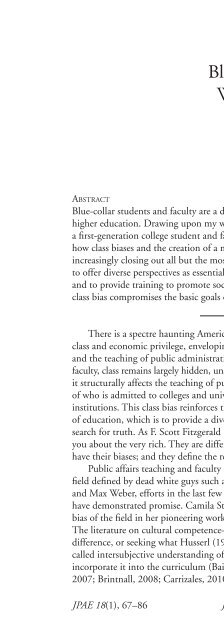WINTER 2012 - National Association of Schools of Public Affairs and ...
WINTER 2012 - National Association of Schools of Public Affairs and ...
WINTER 2012 - National Association of Schools of Public Affairs and ...
You also want an ePaper? Increase the reach of your titles
YUMPU automatically turns print PDFs into web optimized ePapers that Google loves.
Bin Chen, Feng Wang <strong>and</strong> Jianmin Song<br />
permissions by the Ministry <strong>of</strong> Education to launch MPA degree programs.<br />
These universities enroll about 15,000 to 20,000 students annually to pursue<br />
MPA degrees (Jing & Berman, 2008).<br />
The literature on China’s MPA education tends to focus on the supply side:<br />
program design, curriculum development, <strong>and</strong> faculty teaching <strong>and</strong> research.<br />
For example, some scholars reviewed the history <strong>of</strong> China’s MPA education<br />
<strong>and</strong> highlighted its Chinese characteristics (Tong & Straussman, 2003). In<br />
addition to pinpointing economic <strong>and</strong> administrative reforms that have driven<br />
the emergence <strong>of</strong> MPA education in China, Yang (2005) argued that the current<br />
status <strong>of</strong> China’s MPA education reflected a balance <strong>of</strong> internationalization <strong>and</strong><br />
localization. Other scholars conducted comparative studies <strong>of</strong> MPA education<br />
in the United States <strong>and</strong> China in terms <strong>of</strong> curriculum design (Wang, Guo,<br />
& Ma, 1998) <strong>and</strong> teaching styles (Infeld & Li, 2009). Competing paradigms<br />
<strong>of</strong> New <strong>Public</strong> Management, New Governance, <strong>and</strong> <strong>Public</strong> Values were found<br />
to influence course content <strong>and</strong> pedagogy <strong>of</strong> China’s MPA curriculum (Wu<br />
& He, 2009). By looking into Chinese public administration journal articles,<br />
Lu <strong>and</strong> Chow (2008) pointed to two <strong>of</strong> the weakest links <strong>of</strong> China’s public<br />
administration research: theory building <strong>and</strong> knowledge advancement. Jing<br />
(2008) further demonstrated six inadequacies <strong>of</strong> China’s doctoral dissertation<br />
research in public administration: research question, validity, theory relevance,<br />
causality, importance, <strong>and</strong> innovativeness. However, less work to date has been<br />
done on the dem<strong>and</strong> side—Chinese MPA students; only one study has examined<br />
the training experience <strong>of</strong> 10 Chinese municipal <strong>of</strong>ficials in the United States<br />
(Ye, Sun, & Wu, 2009).<br />
This paper addresses this void by exploring the development <strong>of</strong> academic<br />
<strong>and</strong> social networks among Chinese MPA students. Like any other pr<strong>of</strong>essional<br />
graduate degree programs, students can benefit from a MPA degree program by<br />
acquiring <strong>and</strong> updating their pr<strong>of</strong>essional knowledge, obtaining an advanced<br />
degree, <strong>and</strong> developing their social networks. For any effective managers—<br />
whether in the public, nonpr<strong>of</strong>it, or for-pr<strong>of</strong>it sector—to be successful in their<br />
careers, they need to develop their networking competency (Kotter, 1982). Given<br />
the exponential growth <strong>of</strong> MPA programs in China, it is <strong>of</strong> great theoretical <strong>and</strong><br />
practical interest to examine whether <strong>and</strong> how these pr<strong>of</strong>essional public service<br />
training programs would help develop students’ academic <strong>and</strong> social networks.<br />
In this paper, we address this research question: To what extent have<br />
academic <strong>and</strong> social networks been developed among Chinese MPA students?<br />
As an exploratory study, we report the findings from a social network survey<br />
<strong>of</strong> 100 students who were enrolled in a Chinese university’s MPA program.<br />
By employing a network analytical approach, we examine the structural<br />
characteristics <strong>of</strong> academic <strong>and</strong> social networks <strong>of</strong> relationships developed among<br />
Chinese MPA students who participated in the survey. How strongly are they<br />
connected? Which network is more prevalent, centralized, <strong>and</strong> cohesive? Does<br />
138 Journal <strong>of</strong> <strong>Public</strong> <strong>Affairs</strong> Education

















